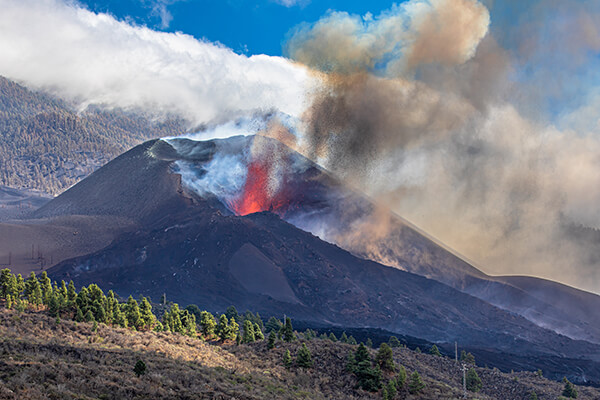A remarkable story circulated online a few weeks ago, but we wanted to retell it here for those that hadn’t seen it.
On September 19th, 2021, the volcano Cumbre Vieja began to erupt on the island of La Palma in the Canary Islands. Lava has covered at least 2500 acres of land, thousands of people have been evacuated, and entire towns have been obliterated by the vast expanse of lava flowing down the volcano towards the Atlantic Ocean. A new peninsula has even been formed by multiple lava flows reaching the water and then continuing out into the sea. Even those settlements that were safe from the lava flows have suffered consequences, with huge amounts of volcanic ash falling across the island and burying the landscape beneath it. (The only confirmed human casualty associated with the volcano was an older man whose roof collapsed while he was trying to clean ash off of it.)
Among the many things buried in ash by the eruption were six bee hives. On November 6th, 48 days after the eruption began, beekeepers finally returned to the hives to determine what had happened. To everyone’s delight and astonishment, the bees had survived! (Or rather, five of the six colonies had survived, while the weakest colony perished.) With multiple feet of ash piled up to and over the hive roofs, how could the bees possibly have made it that long?
How did the honey bee colonies survive the volcano?
One lucky break came from the particular type of ash that covered these hives. Though the bees were only about 2000 feet from the volcano, the type of ash that covered them included some particles that allowed air to pass slowly through the ash pile, giving the bees air to breathe. Even though they have “furry” bodies, it’s important for us to remember that bees aren’t tiny little mammals. As insects, they have a remarkable tolerance for high levels of carbon dioxide, and low levels of oxygen. With just a small amount of gas exchange, these bees could survive for more than a month buried in an ash pile that would have suffocated a human in a matter of minutes.
But the real “luck” here was that, of all the animal species in the entire world, the animals facing this challenge were honey bees! Honey bees may be nature’s most experienced and talented “endurance survivalists”:
- A honey bee colony keeps a multi-month reserve of food in their hive whenever possible.
- With that stored food, they can avoid starvation, and can even generate additional heat if the hive temperature drops too low.
- If they aren’t actively raising brood, they can survive at a much lower temperature than is needed for healthy brood development, conserving “fuel.”
- As they metabolize their stored honey, water molecules are produced and exhaled by the bees. They can reclaim this water from the walls of their hive to keep hydrated.
- Bees hold in their “bodily functions” until they can safely leave the hive, even if that takes months.
- Bees can use their wings to move air around in their hive, improving ventilation even if they are buried under ash.
With all of these amazing traits, is it really that surprising that these colonies could survive under the volcanic ash?
Now despite this remarkable feat, Betterbee does NOT recommend that you find an actively erupting volcano to set up your next apiary. Of the five colonies that survived, it’s safe to guess that they will need supplemental feeding to make up for their lost reserves. It surely won’t help these bees that many of the flowers in their foraging range were also covered in volcanic ash. The toxic gasses and tiny ash particles can harm the bees, particularly by damaging the waxy cuticle around their bodies that helps them avoid drying out. The La Palma colonies have made it through their hardest trial, but they will still need the care of a beekeeper if they want to survive into the future.
Being buried in volcanic ash and being cooped up in your hive all winter are surprisingly similar challenges for our bees. Bees must rely on their food reserves and the behavior of their nestmates to create a habitable environment while surrounded by a very inhospitable environment. Our main takeaway from the La Palma hives is the same lesson we try to teach our beekeepers about winter survival: Of the six colonies that were buried in ash, the only one that didn’t make it was already a weaker colony. Bees can survive a long winter (or a month and a half under volcanic ash) but only if they go into those challenges in good health, and with good food reserves. Mismanaging your bees’ honey reserves, or ignoring varroa mites, or any other beekeeper negligence can doom a colony going into a few challenging months, despite the remarkable ability of honey bees to keep themselves alive in very harsh conditions.
Read more about bees and volcanoes:
https://old.reddit.com/r/Damnthatsinteresting/comments/qu8002/thousands_of_bees_survived_the_la_palma/
https://nationalpost.com/news/world/thousands-of-bees-make-it-out-alive-after-being-buried-by-la-palma-volcano-ash-for-50-days
https://cms.ctahr.hawaii.edu/pollinators/volcanoes

